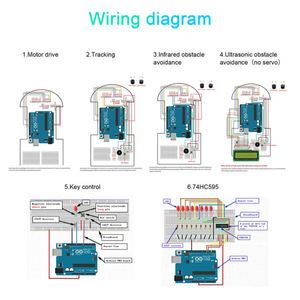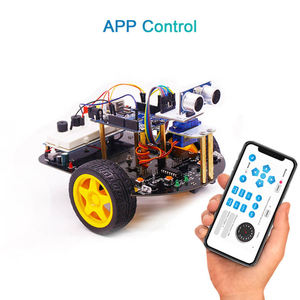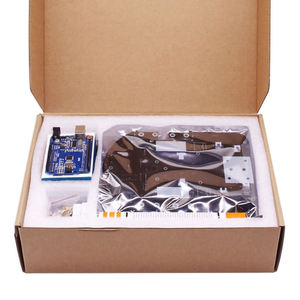(1618 products available)



























































































































































































Starter robot kits have gained immense popularity due to their educational benefits and hands-on experience in robotics, electronics, and programming. These kits cater to beginners of all ages, offering a range of options to suit various interests and skill levels. They provide a practical introduction to STEM concepts, fostering skills in problem-solving, critical thinking, and creativity. With components like sensors, motors, and microcontrollers, users can build and code functional robots, enhancing their understanding of engineering and technology. The immersive learning experience these kits offer is invaluable, preparing individuals for future opportunities in the evolving field of robotics and automation.
Starter robot kits come in a range of types, each designed to cater to different interests and skill levels. These kits offer a practical introduction to robotics, electronics, and programming, making them suitable for beginners of all ages.
Educational robot kits
These kits are made to be used in classrooms or for self-study. They usually come with detailed instructions and learning materials that cover various STEM topics. Additionally, these kits help learners understand the principles of engineering, coding, and electronics through hands-on activities.
Programmable robot kits
These kits are designed for people who are interested in basic programming. Usually, they come with a microcontroller and various sensors and motors that allow users to build customized robots. In addition, users can write their own code to control the robot's actions and functions. This will help them learn programming languages like Python, C++, or block-based coding environments like Scratch.
Arduino robot kits
This type of robot kit is based on the popular Arduino microcontroller. Typically, they are meant for people who are interested in electronics and programming. Usually, they come with Arduino boards, sensors, motors, and other components that allow users to build customized robots. Normally, they allow users to write their own code to control the robot's actions and functions. This will help them learn programming languages like Python, C++, or block-based coding environments like Scratch.
Raspberry Pi robot kits
These kits use the Raspberry Pi single-board computer as the main control unit. Essentially, they are meant for people who have a little more knowledge in electronics and programming. Normally, they come with a Raspberry Pi, sensors, motors, and other components, allowing users to build complex robots with a wide range of functionalities. Besides, users can use programming languages such as Python, C++, or Java to write their own code to control the robot's actions and functions.
Humanoid robot kits
These kits are meant to help users build humanoid-shaped robots. Typically, these kits can be simple or complex, with basic humanoid robots having limited movements and advanced kits offering full customization and programmability. Additionally, these kits are useful for studying robotics, animation, and AI.
Obstacle-avoiding robot kits
These kits enable the user to build robots that can move independently and avoid obstacles. Usually, they come with sensors that detect obstacles and change the robot's direction. Essentially, these kits are ideal for beginners who want to learn about basic robotics and programming.
When choosing a starter robot kit, consider the following factors to find one that fits the needs:
Know the interest and purpose
It is important to determine what the user wants to achieve with the robot kit. This is to say, if it is meant to be used for learning purposes, exploring new technologies, or having fun. If the goal is to learn about programming, a robot kit with customizable features and a programming interface should be considered. On the other hand, if the aim is to have fun, then a robot kit that is ready to use with multiple pre-built functions and a graphical interface should be used.
Check the skill level
The user's skill level is also an important factor to consider when choosing a ideal starter robot kit. If the user is a beginner, then a robot kit with a simple assembly process, clear instructions, and a comprehensive guide should be considered. However, if the user has some experience in robotics, then a robot kit with more challenging projects and programmable features should be considered.
Consider the type of robot
Different types of robot kits serve different purposes. For instance, some kits offer moving robots, while others offer line-following robots. Thus, it is advisable to choose a kit that matches the user's interest.
Assess the components and materials
The quality of the materials and components should also be assessed. This is to say that durable materials such as good-quality plastics or metals should be prioritized. Additionally, electronic components such as sensors, motors, and microcontrollers should be considered as they are essential for building a functional robot.
Evaluate the educational value
It is important to evaluate the educational value that a robot kit offers. A kit with detailed instructional manuals, educational materials, and online resources should be prioritized. This will help the user understand the concepts of robotics better.
Look for support and community
A community or support system should be looked for as it will help the user in solving problems and sharing experiences. Thus, a robot kit with active forums, online communities, and customer support should be prioritized.
Budget considerations
The budget for the robot kit should be considered. Kits with different price ranges offer varying features and complexity levels. Therefore, a comparison of the cost of the kit with the components and functionalities it offers should be done to ensure the best value for money is obtained.
The primary purpose of starter robot kits is to introduce beginners to the fundamentals of robotics. These kits provide the components and instructions for building simple robots that can be used to help learners understand how robots are built, programmed, and function. Another role of the robot starter kit is to provide an interactive and hands-on approach to learning STEM subjects. When assembling and programming a robot, one must solve problems and apply mathematical and scientific concepts, thus making the theory more practical and relevant.
Components
This includes wheels, gears, sensors, motors, and microcontrollers. These parts are the building blocks of the robots that learners create.
Educational Materials
These kits come with manuals that have step-by-step instructions and additional information about the concepts they cover.
Programming Tools
These are software or applications that help users write and upload code to the robot's microcontroller. They also allow users to use block-based coding languages like Scratch or Python.
Power Supply
This refers to batteries or rechargeable power sources that ensure the robot has power to run.
Chassis and Structure
The starter robot kit includes a frame or base on which all other components are mounted. This provides stability and support to the robot.
Wheels and Mobility Components
These include wheels, tracks, and motors that drive the robot and determine how it moves.
Hardware Essentials
These are screws, bolts, and brackets that hold the robot together.
Customization Parts
These add-ons and accessories allow users to personalize their robots and make them unique.
The design of a beginner robot kit is intended to make learning easy and enjoyable. The kits have various components that are easy to assemble, such as snap-together parts and modular pieces. This helps to minimize frustration and encourage creativity among the users. The instructional materials that come with the robot kits are designed to be easy to read and understand. They also contain illustrations, diagrams, and troubleshooting tips. This makes it easy for learners to comprehend the building and programming concepts.
Safety and quality should be the first considerations when choosing a robot kit for starters. A safe kit has no sharp edges and has parts that cannot cause choking. It should also have components made of non-toxic substances. The kit should come with instructions that are easy to understand and that clearly outline the safety measures that need to be taken. This includes how to handle the robot when it is powered up and when it is not powered up. The kit should also have other additional safety features like protective gear, automatic shut-off, and clear warning signs.
A quality robot kit is made of quality materials that are durable and are easy to use. The quality of the tools and components included in the kit should also be high. The robot kit should also have quality sensors and motors that make it efficient in performing various tasks. It should also be easy to use with well-documented instructions that one can easily follow. The quality of the support and resources provided by the manufacturer should also be high. This includes online tutorials, forums, and customer service that are helpful.
What materials are typically included in a starter robot kit?
In a typical robot kit for beginners, the materials needed to build a starter robot are usually included. The pack contains essential items like various sensors and microcontrollers, among other necessary components such as motors and wheels, along with a structured guide that aids in the assembly process.
Are starter robot kits suitable for younger children?
Yes, starter robot kits can be suitable for younger children. However, it's important to select kits specifically designed for their age group, with user-friendly components and instructions. Such kits often include safety features and are made of non-toxic materials, ensuring a safe and educational experience.
How much do starter robot kits typically cost?
The cost of starter robot kits can fluctuate based on factors like complexity, included components, and brand reputation. Typically, they are priced from a few dollars to approximately 100 dollars. It's advisable to check the current market prices for the most accurate information.
Can starter robot kits be used for educational purposes?
Yes, starter robot kits are often utilized for educational purposes. They provide practical learning experiences in fields like mathematics, science, and technology. Such kits facilitate hands-on engagement, allowing students to comprehend theoretical concepts more thoroughly by applying them in practical, real-world scenarios.